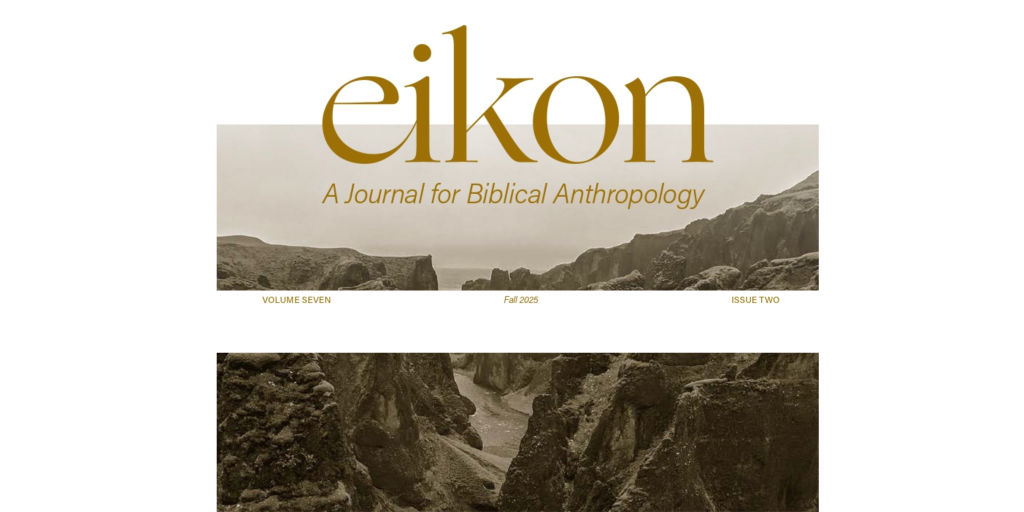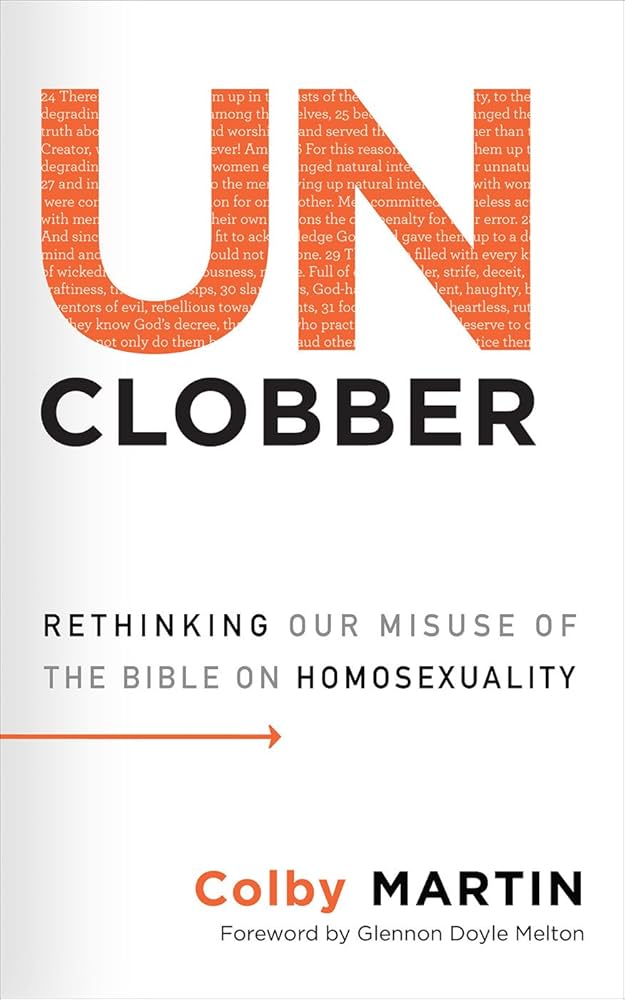Book Review: “UnClobber: Rethinking our Misuse of the Bible on Homosexuality”
By: Deirdre Buscetto

Editor’s Note: The following review appears in the Fall 2025 issue of Eikon.
Colby Martin. UnClobber: Rethinking our Misuse of the Bible on Homosexuality. Louisville, KY: Westminster John Knox Press, 2016.
Introduction
I did not hear the gospel until I was fifty–five years old. One of the pathologists I worked with in Gulfport, Mississippi came to saving faith and brought me the gospel. Two years later the Lord called me, gave me faith, justified me, and I embraced Jesus Christ as Lord and Savior. One of the many sins the Lord saved me from was thirty-seven years of homosexuality. I praise God for his mercy and grace for me, a sinner. While I also praise him for the grace he showed me by opening my eyes to see and my heart to embrace biblical truth regarding homosexuality and sin, many others, it seems, are turning the other way.
Colby Martin, the author of UnClobber: Rethinking Our Misuse of the Bible on Homosexuality, is one such figure today. Martin and his wife are co-pastors of Sojourn Grace Collective, a progressive Christian church in San Diego, California. Martin grew up in a Baptist household and left conservative evangelical theology because his feelings did not align with his beliefs.
Summary
What is a “clobber passage” anyway? This phrase refers to six passages in the Bible which are used to support the view that homosexuality is a sin. They are called “clobber” passages because the church has used these passages to confront or “clobber” those who deny homosexuality as sin. The phrase arose in the LGBT community in the 1990s.[1] In UnClobber, Martin is convinced, based on his personal experience and study of Scripture, that these passages can be “un-clobbered.” In other words, the traditional interpretations of these texts are wrong, and “God does not stand opposed to those who are attracted to the same sex and he divinely blesses same-sex relationships” (xiii). In reality, they do no such thing.
Beginning with personal testimony in chapters 1–3, Martin weaves his journey from conservative evangelicalism to progressive Christianity around various chapters examining the “clobber passages.” The major impetus for Martin’s turn to progressive Christianity was his reading of A New Kind of Christianity,[2] which provided progressive interpretations of Scripture. These interpretations aligned with his emerging acceptance/feelings regarding homosexuality. As a result, he deconstructed his faith. His book is dedicated to teasing out these progressive interpretations of Scripture.
Chapter 4 outlines Martin’s argument regarding Sodom and Gomorrah. He claims those two cities were destroyed because the people in those cities were inhospitable to Lot’s visitors, not because of the sin of homosexuality (59). According to “common sense and statistics every man in these cities could not possibly have been gay” (54). Therefore, the surrounding of Lot’s house is not a “judgment against homosexuality as an orientation or same-sex attraction, but about a display of dominance for the sake of power and control” (55–56). Martin states that the main point of this story is to reflect the opposite of the hospitality Abraham showed the Lord and his two messengers in Genesis 18 (56).
In chapter 6, Martin raises four notable points regarding Leviticus 18:22 and 20:13. First, the Hebrew nouns in verse 22 are “vague and uncertain” (86–88). Second, the second half of the verses are “superfluous” (86–87). Third, there is no mention of “lesbianism” in these verses (88). And fourth, the Hebrew word toevah (abomination) is not “rooted in evil or immoral actions but were actions that crossed the (cultural) boundary markers set by God for Israel” (92–93). Martin is convinced that these four observations support the conclusion that these verses contain “ambiguities and uncertainties that are shaky ground. . .that God clearly prohibits homosexuality in the Old Testament” (88).
Martin makes four important points regarding Romans 1:26–27 in chapter 8, referring to Paul’s teaching that homosexual acts are dishonorable. First, the Greek word for dishonorable refers to something “culturally shameful but not wrong or sinful” (128). Second, the word “shameless” indicates “behavior that is unseemly or indecent” (129). Third, the phrase “according to nature” refers only to a “procreative act between a man and a woman, not the morality of the act” (131). Fourth, the statement “women having sexual relations contrary to nature” must mean “anal heterosexual sex with men which is nonprocreative” (132). Martin concludes that these verses provide “an explanation of how Jewish people saw the plight of godless pagans who. . . embraced idolatry. . .committed sexual immorality. . . shameful and offensive to Jewish sensibilities. . . against nature by being non-procreative” (132–133).
In chapter 10, Martin treats both 1 Corinthians 6:9 and 1 Timothy 1:10. There are two assertions Martin makes about Paul’s reference to “men who practice homosexuality.” First, these verses are not about “homosexual orientation or about two men in a mutually loving committed relationship” (162). This conclusion is based on his assertion that the Leviticus passages “had no word against people born with same-sex attraction, nor a same-sex couple in a loving committed relationship” (162). Second, Paul is condemning “exploitative (pederasty) and economic (prostitution)” same- sex acts (162). Martin supports this claim by stating Paul had no category for a person’s sexual orientation, so he could only envision “exploitative” or “economic” same-sex interactions (164). Therefore, these passages do not address or condemn mutually committed and loving relationships. Where does Martin leave us with his personal anecdotes and biblical interpretations? He claims that, on one hand, we can affirm homosexuals and still maintain a “high view of Scripture” (165), but that,on the other hand, the Bible does not condemn “homosexuality as an orientation nor does it condemn same sex committed relationships” (171).
Critical Interaction
Despite Martin’s attempt to “unclobber” these six passages of Scripture, there are at least three foundational problems with Martin’s interpretations. First, he rejects the Bible’s authority and interpretations of biblical passages. Instead of allowing Scripture to reshape his thinking and feelings, he allows his feelings to rule over and interpret Scripture. Second, he does not employ a biblical-theological approach to interpreting Scripture by examining the textual, epochal, and canonical horizons of the text.[3] For instance, the background for Genesis 19 is Genesis 13:13 and 18:20–21. In Genesis 13:13, the term “wicked” means morally corrupt, evil in character and deed persistently.[4] Notice this verse describes only the men in Sodom. In Genesis 19:7, when Lot addresses the men regarding their intentions towards the visitors, the term “wicked” refers to behaving in a morally corrupt way (BDB, HALOT)[5]. Also, Martin does not discuss the meaning of the Hebrew word “to know,” which is yada. In this context, yada means to know sexually (BDB, HALOT)[6]. This meaning is evident when Lot offers his two daughters to these men. In Genesis 4:1, the word “knew” clearly refers to sexual relations. Judges 19:22, 25 contain the words “know” and “knew” which plainly refer to sexual relations. Obviously, these passages, combined with the background for Genesis 19 as well as Genesis 19:7 regarding the word “wicked,” refer to the sin of homosexual rape of Lot’s visitors. While Martin does examine other passages of Scripture, such as Ezekiel 16:49–50, Isaiah 1:9, Jeremiah 23:14, as well as Matthew 10:14-15 to aid in the interpretation of Genesis 19, he misinterprets them (57–60). Significantly, Martin ignores Jude 7 and 2 Peter 2:2–10, two texts which clearly and directly reveal the sexual sin of Sodom and Gomorrah.
Third, Martin does not engage with the creation narrative. Failure to include and rightly interpret Genesis 1–3 is a sure way to interpretations that result in unorthodox theological conclusions.[7] The creation narrative provides a clear mandate for heterosexual marriage and implies that God does not affirm any other type of “loving committed relationship” meant to replace and redefine marriage. In addition, God’s mandate for sexual activity only within the covenant of marriage implies that same-sex sexual relations are contrary to the created order and therefore a sin.[8] The creation narrative also establishes what is according to nature and by implication what is contrary to nature. This is the basis for Paul’s argument in Romans 1:26–27. Martin also fails to consider Genesis 3, the fall and the origin of sin. Genesis 3, combined with the covenant of marriage, provides a solid foundation to understand why homosexual sexual relations of any kind are sinful. This failure is reflected in Martin’s claim that homosexuals can be Christians.
Conclusion
Martin’s attempts to “unclobber” these six passages fall short. He rehearses well-worn liberal interpretations of the six common passages from Scripture that are used in the homosexual debate.[9] His theological interpretations are false because he does not use a biblical-theological approach to interpret Scripture and he does not properly consider Genesis 1–3 in his examination. Consequently, this book is a great resource to interact with to understand and refute unorthodox, liberal interpretations of the six passages of Scripture commonly used in the homosexual debate.
[1] Don Lattin. “Ministries Try to Turn Gays Straight.” San Francisco Chronicle, Sept 19, 1990.
[2] Brian McClaren, A New Kind of Christianity (New York, NY: Harper One, 2010).
[3] Richard Lints, The Fabric of Theology: A Prolegomenon to Evangelical Theology (Grand Rapids: Wm. B. Eerdmans, 1993), 293–311.
[4] Francis Brown, S. R. Driver, and Charles A. Briggs, A Hebrew and English Lexicon of the Old Testament (Oxford: Clarendon Press, 1907), s.v. “רַע” and Ludwig Köhler and Walter Baumgartner, The Hebrew and Aramaic Lexicon of the Old Testament, trans. M. E. J. Richardson (Leiden: Brill, 1994–2000), s.v. “רַע.”
[5] Brown, Driver, Briggs, Hebrew and English Lexicon, s.v. “רָעַע” and Koehler and Baumgartner, Hebrew and Aramaic Lexicon, s.v. “רָעַע.”
[6] Brown, Driver, Briggs, Hebrew and English Lexicon, s.v. “יָדַע.”
[7] Stephen J. Wellum, Systematic Theology: From Canon to Concept (Nashville: B& H Academic, 2024), 398.
[8] Thomas R. Schreiner, “A New Testament Perspective on Homosexuality,” Themelios 31, no. 3 (April, 2006), 62.
[9] For two excellent books regarding refutations of progressive interpretations of the six passages from the Bible used in the homosexual debate, please see: Robert A. J. Gagnon, The Bible and Homosexual Practice: Texts and Hermeneutics (Nashville: Abingdon Press, 2001) and James R. White and Jeffrey D. Niell. The Same-Sex Controversy: Defending and Clarifying the Bible’s Message About Homosexuality (Minneapolis: Bethany House Publishers, 2002).
